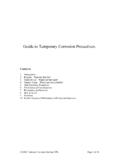Transcription of TEMPORARY CELLULAR COFFERDAM DESIGN, …
1 TEMPORARY CELLULAR COFFERDAM DESIGN, INSTALLATION & REMOVAL AT WILLOW ISLAND HYDROELECTRIC PROJECTA technical paper presented by:The Ruhlin Company &Mueser Rutledge Consulting EngineersFirst presented at HydroVision 2014 TEMPORARY CELLULAR COFFERDAM DESIGN, INSTALLATION, AND REMOVAL AT WILLOW ISLAND HYDROELECTRIC PROJECT Page 1 of 43 Michael Ciammaichella, PE James Tantalla, PhD, PE Vice President, Civil Division Manager Associate The Ruhlin Company Mueser Rutledge Consulting Engineers Sharon Center, OH New York, NY USA USA Abstract For a hydroelectric powerhouse to be constructed along the Ohio River at Willow Island, a CELLULAR COFFERDAM was necessary to control ground and surface waters from entering the required 110-foot deep excavation.
2 The Ruhlin Company was contracted to manage the design and construction of the COFFERDAM . Analysis was performed for various load cases ranging from normal pool elevations to flood conditions. Engineering solutions included rock anchors to mitigate poor rock strengths, support of earth structures, weighted berm, dewatering wells, and unique tie-in to existing dam pier utilizing steel closure caisson and steel waterstop plate. Challenging site conditions played a key role in the design. The overall structure, designed by Mueser Rutledge Consulting Engineers to provide protection to 100-year flood levels, included CELLULAR steel sheet pile COFFERDAM , tie-in to the existing dam structure, emergency flooding structure, deep seated slope stability and instrumentation and monitoring.
3 Design also included engineering analyses for sliding, overturning, pullout, cell interlock stress, wye interlock stress, vertical shear, horizontal shear, and deep seated stability. Sheetpile cells consisted of foot diameter cells constructed with PS sheets for an average height of 67 feet. The entire undertaking took into consideration the USACE Engineering Manual, with a focus on factors of safety. Installation required river access while working from barges and providing sufficient granular material in the river bottom to seat sheet piling while driving into bedrock. The structural steel template used during sheet pile installation remained in place during sand backfill operations to maintain cell shape and stability.
4 Upon completion of the powerhouse, removal sequence will closely follow reverse order of the installation process; however, system stability during deconstruction is a major consideration. Page 2 of 43 1. Introduction American Municipal Power, a nonprofit organization that owns and operates electric generation facilities for its member communities, has been in the process of constructing hydroelectric power plants adjacent to existing navigation locks and dams along the Ohio River. The Willow Island Hydroelectric Project is one of them, and is currently under construction on the West Virginia bank of the river at the existing US Army Corps (USACE) Willow Island Lock and Dam.
5 The plant will be located on the opposite bank to the lock. The powerhouse will encompass two turbine generating units with an estimated capacity of 35MW at a 20 foot head differential. The Ruhlin Company of Sharon Center, Ohio, has been awarded contracts to construct both the COFFERDAM and the powerhouse. Construction began in mid-2011, and the plant is expected to come online in 2015. General COFFERDAM Configuration The COFFERDAM for the project was designed to allow excavation and construction of the powerhouse, intake, and tailrace channels in the dry while maintaining upstream to downstream pool separation (a 20 foot head differential under normal pool conditions) before being flooded and decommissioned.
6 It has been designed to provide protection up to 100 year flood levels, which raise the river 20 feet (upstream) to 40 feet (downstream) over normal pool levels. The COFFERDAM has been outfitted with an emergency floodgate and spillway to allow safe flooding if the river is predicted to exceed those levels. Deep dewatering wells are being used to draw down groundwater during overburden excavation and for depressurization of bedrock during rock excavation. The COFFERDAM was designed by Mueser Rutledge Consulting Engineers (riverside, SOE, and rock anchors) and Geocomp (landside, stability analyses and instrumentation). All components of the design have been reviewed by the Owner s Engineer, MWH Americas, Inc.
7 , and were reviewed and approved by the Federal Energy Regulatory Commission (FERC) and the USACE. An aerial photograph of the COFFERDAM is shown in Figure Page 3 of 43 Figure - Willow Island Hydroelectric Project COFFERDAM Key COFFERDAM components are identified in Figure The COFFERDAM consists of a 50 foot deep soil bentonite cut-off wall constructed from existing grade beneath an impermeable clay cap up to 25 feet tall around the landside of the COFFERDAM . On the riverside, a CELLULAR COFFERDAM consisting of sixteen 62 foot diameter, 67 foot tall cells was installed to the top of rock. Thirty high capacity rock anchors, some requiring support of excavation (SOE) to allow proper location, are installed around the site to maintain stability if a 100 year flood were to occur.
8 The COFFERDAM allowed the excavation for the powerhouse, including up to 60 feet of rock excavation, to proceed in the dry while water levels on the Ohio are more than 120 feet above the deepest excavation. Page 4 of 43 Figure - Site Plan and COFFERDAM Components General Site Geology The overburden at the site consists of alluvial sands and gravels overlain by finer grained silts and clays. The deeper, pervious sands and gravels allowed the use of a widely spaced deep dewatering well system for managing groundwater on the site. Thickness of the overburden varied from 0 feet in the river to as much as 60 feet thick on land, still several feet below the 100 year flood level the COFFERDAM was designed to protect against.
9 The top of bedrock was generally found at about El. 558 according to the Ohio River Datum. The bedrock consists of the Pennsylvanian Conemaugh Group, and consists of a variety of interbedded sedimentary rock types, including sandstones, siltstones, shales, claystones, and indurated clays with occasional limestone encountered during the project subsurface investigations. Rock stratigraphy was highly variable both vertically and horizontally throughout the site. Rock jointing was found to be generally low angle with varying dip directions. Evidence of slickensides was encountered in some of the borings, particularly in the finer grained sedimentary rocks. Based on the presence of slickensides in low angle joints, the design of the COFFERDAM included low Page 5 of 43 strengths ( =14 ) along potential horizontal failure surfaces with higher strengths across rock bedding.
10 Groundwater on site is generally controlled by river levels, with fluctuations in soil groundwater levels generally lagging behind river levels and water levels within the rock dictated by communication through jointing. During construction of the existing dam, the USACE identified a fault beneath the planned overflow weir and Pier 9, both of which are within the footprint of the COFFERDAM for the construction of the powerhouse. See Figure A further investigation identified the fault with a strike of N(75-80) W and dip of 30 . The fault is up to several feet thick, and rock within the fault is highly fractured. Design of the CELLULAR COFFERDAM , in particular deep seated sliding stability, carefully considered the presence of this fault on site.





